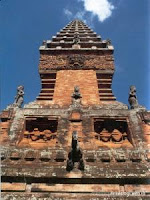 Near the market in the village of Kapal you will find the beautifully decorated temple of Pura Sada. Originally a sanctuary of the Mengwi royalty, it dates to the Majapahit era. It has a 16 meter high tower, but, it is the 64 stone shrines resembling ancestral shrines that are the feature of this temple. They are believed to commemorate fallen warriors.
Near the market in the village of Kapal you will find the beautifully decorated temple of Pura Sada. Originally a sanctuary of the Mengwi royalty, it dates to the Majapahit era. It has a 16 meter high tower, but, it is the 64 stone shrines resembling ancestral shrines that are the feature of this temple. They are believed to commemorate fallen warriors.
The temple shrines are located in the main courtyard. Among the shrines there is 20-meter-high 11-roofed red-brick shrine, just under which there is room for a statue. Legend has it that a long time ago in Gowan, Mainland
One day the king collected the ashes of Dewi Manik Galih, a goodness of life, and then set sail to scatter the ashes into the ocean. Two ships were prepared, donated by Sanghyang Durwasa, the king of Konca. The ashes were put in a container called a “likya”. The king went on the journey wit 8,000 of his people. Before they set off, he told them to abstain from sexual activities during the journey to keep danger away.
Meanwhile, Bhatara Guru (a manifestation of God), had ordered the gods and goddesses to create a new island to the east of the island of Java. The “Likya” of Dewi Manik Galih’s ashes was going to be placed on this new island, which was later connected to Java. The gods and the goddesses were now waiting for the arrival of the two ships. However, aboard the ships, some of the people broke their king’s rules and the ships sank. As they were sinking, a voice was heard in the sky demanding that the ashes be scattered on the island and Dewi Manik Galih be worshipped as the goddess of the earth and referred to henceforth as Bhatara Sri Murthi. The part of the sea where the ships sank solidified and turned into a new island, which was initially called Gelgel Jagat Kapal (“Jagat” literally meaning “World”). This site was the first part of the island to emerge from the sea, and was later called Jagat Kapal (the
The shrine, located in the innermost courtyard, was later called “Pura Sada” because the king who built it came from the Pura Sada kingdom.
Location
Kapal is just 15kms northwest of Denpasar on the main Singaraja Road to Mengwi. Buses and bemos serve all day on the Denpasar-Mengwi run. Bali itself is served by the international







